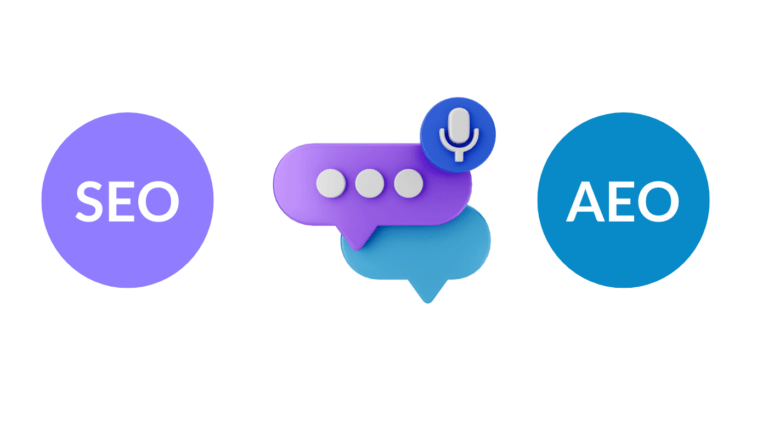Answer Engine Optimization: The Next Meta Frontier of SEO
Answer engine optimization (AEO) is the next-gen subset for search engine optimization, focusing on content optimization to answer user questions directly. While traditional SEO targets keywords, AEO targets the rank content along with the keyword. This specifically optimizes to rank content in search engine answer boxes and featured snippets. The progress of AEO has been observed over time with the rise in voice searches and the need for optimization. Let’s explore the depth of AEO.
What is Answer Engine Optimization?
Answer Engine Optimization (AEO) has gained popularity overtime with the rise in virtual assistants, more voice search, direct answers to user queries and the increasing demand for quick answers. Today, users prefer on-point answers, giving a green signal to digital marketing agencies to focus on content and answers more than keywords. These are displayed as answer boxes or featured snippets. While AEO is becoming the future of SEO, here are some of the differences between the two you must know.
AEO Vs. SEO: What Is In Trend Today?
Both SEO and AEO leverage strategies to improve user experience and brand visibility. However, the idea for the two can be different.
Although both the terms are related with the same purpose, there are several fundamental differences that need to be understood. After all, the future is going to be for both SEO and AEO.
- AEO strategies focus on optimizing content specifically to appear in featured snippets and knowledge panels. The purpose is to provide direct answers to user questions and to deliver precise and quick responses to queries.
- On the other hand, SEO for digital assistance has a broader scope, seeking to improve overall organic search traffic and rankings across a wider variety of keywords and content formats like blogs, images, and videos.
The difference between AEO vs SEO is inclined to the strategies fitting different user intent signals. AEO targets long-tail, question-based searches where the user’s goal is to find a specific answer to the query while SEO focus on short-tail keywords associated with ranking.
An SEO strategy for delivering AEO content will be optimized to match those explicit informational queries. SEO also encompasses short-tail and navigational searches with keywords where the user aims to reach a certain website quickly. Effective SEO strategies require optimizing content across both types of user intent signals, with those looking for answers and those looking for precise websites.
As Google search optimization continues evolving to understand better and meet user needs, the impact of AEO and SEO will remain essential elements of a comprehensive digital marketing approach.
Both AEO and SEO considerably overlap when it comes to the underlying principles of creating valuable content and experiences centered around the user. So, digital marketing agencies strengthen both the engine optimization strategies for organic visibility and search friendliness in future.
Precisely, here is what SEO and AEO is all about.
| Search Engine Optimization | Answer Engine Optimization |
| Relevance | Concise answers |
| Authority | Structured data |
| User experience | Formatting |
| Technical optimization | Heading optimization |
| On-page optimization | Question and answer format |
| Off-page optimization |
With a simultaneous impact of both SEO and AEO, brands can increase their visibility. In fact, AEO has become the future frontier of digital marketing. Here is how.
User Intent And AEO
Digital marketers need to understand user intent and the exact formats of their queries to use the AEO best practices effectively. Whether the user is asking a factual question, a how-to question, or a comparison, the focus of AEO is to directly respond in such a way that it matches the user intent and meaning effectively. Marketers for AEO even have the freedom to customize the content to meet the unique requirements and user experience according to the user search behavior and query type.
The Role Of Structured Data In AEO
One of the important aspects of Answer Engine Optimization is structuring the data so that featured snippets can be easily extracted and shown by search engines. Here are some of the tactics for content optimization for featured snippets and straight answers:
Concise Answers: Providing clear and on-point answers that address the user’s query straight.
Structured Data: Creating structured data markup, such as schema.org, to help search engines understand the context and format of the content.
Formatting: Use of lists, tables, bullet points, and other formatting techniques to present information in a clear and organized manner.
Heading Optimization: Using relevant headings (H2, H3, etc.) to segment the content and make it easier for search engines to identify key information to answer the query.
Question and Answer Format: Structuring content in a question and answer format to respond more precisely to the user queries and improve the chances of appearing in featured snippets.
These strategies can help marketers to make their content more visible in featured snippets and answer boxes. It will increase the likelihood that users will pay attention to it and builds brand authority. Both AEO and SEO together can do miracles. Here is how.
Incorporating AEO Into Your SEO Strategy
Here are some tricks to build a better tuning of AEO and SEO.
1. Conducting Effective Topic Research
While AEO and SEO strategies have a crucial difference, many standard SEO research tactics still apply to optimize content to rank for featured snippets and knowledge panels.
Analyzing search console data, surveying consumer questions and leveraging keyword research tools around a topic are solid starting points to identify relevant answering opportunities.
2. Implementing Relevant Structured Data
Adding structured data like FAQ schema, how-to schemas, and Q&A schemas will help content to meet the technical criteria to rank in many featured snippets and knowledge panels.
Structured data and featured snippets remains vital for visibility in other rich result formats.
The specifics will grow over time, but technically optimizing pages to target relevance as answers to questions will still be important.
3. Accounting For Query Intent Nuance
Not all question searches carry the same intent signals. Precise and short-tail queries still indicate a specific user goal of finding one clear answer. However, lengthier and broad questions still demonstrate a more varied intent with numerous potential responses.
Answer engine optimization content must build structure according to the query purpose, providing comprehensive coverage for broad questions along with offering concise specifics for narrow ones.
4. Building Topical Authority Holistically
Gaining recognition as an authority within search algorithms needs building a breadth of in-depth content around a concept, instead of just targeting keywords.
Another way to build topical authority is to establish topic resonance by creating a wide range of content and interlinking internally around subtopics.
Sites displaying mastery in all aspects of an area, from basic definitions to nuanced discussions. This stands as the best chance of ranking as an authoritative answer for related queries.
How To Implement AEO?
The importance of Answer Engine Optimization cannot be underestimated. It has become a part of the Google Trend and SEO. Considering this, it is crucial to implement it in your practice if you want to leverage your online business. OPositive is equipped with a team of experts offering comprehensive solutions and constant monitoring. Also, strategic implementations as per the updated Google Trends increase the overall website performance.














